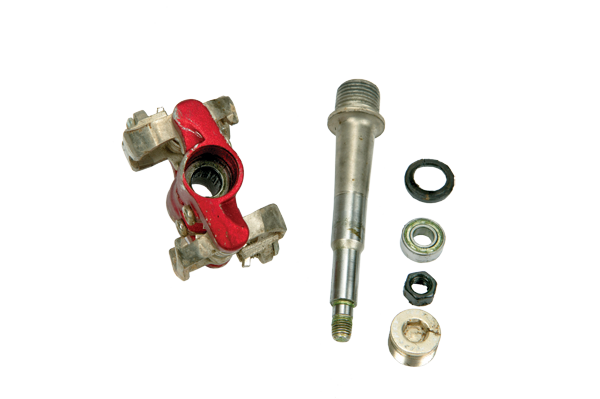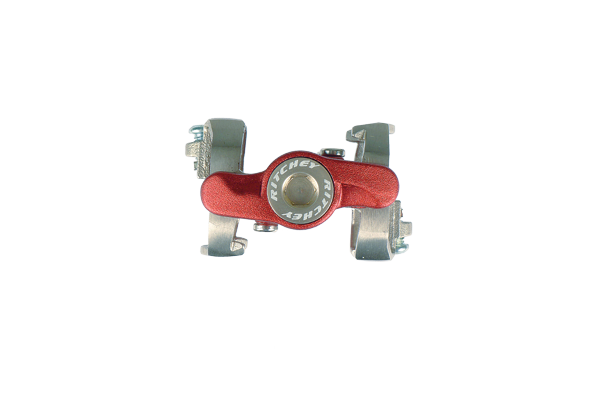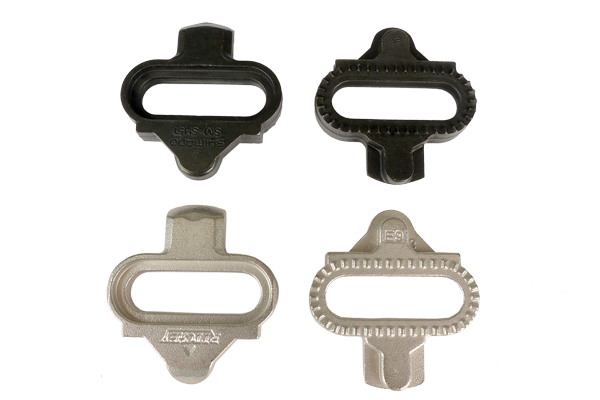Ritchey Paradigm Pedals
 Simple clipless pedal designs (suchas those from Crank Brothers,Time and Look) have gaineda real following but some still prefer Shimano’s SPD retention mechanism. In 1990 Shimano kicked off the clipless pedal revolution for mountain bikers and their design follows similar lines to this day. SPD pedals use dedicated cleat retention plates with separate adjustable springs that allow you to vary the release effort. While they tend to be more mechanically complex than those from Crank Brothers, Look or Time, they offer a really positive and defined action when clipping in and releasing. While some riders prefer the ‘SPD feel’, they usually carry a weight penalty and the added complexity can lead to an inconsistent action in muddy or particularly dusty conditions.
Simple clipless pedal designs (suchas those from Crank Brothers,Time and Look) have gaineda real following but some still prefer Shimano’s SPD retention mechanism. In 1990 Shimano kicked off the clipless pedal revolution for mountain bikers and their design follows similar lines to this day. SPD pedals use dedicated cleat retention plates with separate adjustable springs that allow you to vary the release effort. While they tend to be more mechanically complex than those from Crank Brothers, Look or Time, they offer a really positive and defined action when clipping in and releasing. While some riders prefer the ‘SPD feel’, they usually carry a weight penalty and the added complexity can lead to an inconsistent action in muddy or particularly dusty conditions.
The Paradigm is the latest pedal design from Ritchey, and like their previous offerings it takes its design cues from the Shimano system—in fact the supplied Ritchey cleats appear identical to the Shimano ones. While the Pro Paradigm retention mechanism is similar to Shimano’s, the Ritchey pedals offer decent weight savings and they are as light as many of the more simplistic designs. Our Pro Paradigm pedals came in at 258g for the pair—not bad given the $160 retail price tag. They are 50g a pair lighter than Shimano’s top-end XTR Race pedals and 81g less than the XT version. The Pro Paradigm is also 20g lighter than the minimalist Crank Brothers Egg Beater 3, although the big-dollar titanium enriched Egg Beater 11 remains the lightest at 178g per pair.

Diligent Design
They may be light but the spindle and bearing design isn’t compromised to achieve the minimalist weight. Cromo steel is used for the axles and each pedal turns on three bearings; a small cartridge bearing on the outside, needle roller bearings in the middle and a bushing at the innermost position. Many lightweight pedals just run a tiny outer cartridge bearing with an inner bush, so the needle roller bearing is a reassuring addition. Further to this, the nut that secures the right hand bearing assembly uses a reverse or left-hand thread. As a result, a catastrophic bearing failure will simply tighten the spindle. Some pedals run regular threads on both sides and a seized bearing can lead to the pedal body falling off the spindle, often with a very painful outcome.
After six months of solid use the bearings remain in reasonable condition. Both pedals have developed a small amount of play at the inner bush but the needle roller bearing seems to keep any movement in check—they aren’t getting progressively worse like some bearing/bush equipped pedals that I’ve tried. They are easy to service too; a 9mm socket tool and a 6mm allen key is all you need to disassemble and regrease the pedals. Ritchey also lists full rebuild kits for the Paradigm which includes all the bearings and seals.
In a side-by-side comparison, I couldn’t pick the difference between the supplied Ritchey cleats and Shimano’s SH51 cleats. I also used the pedals with Shimano cleats and couldn’t detect any performance difference. While Ritchey only recommends their cleats, it’s good to know that they’ll also work with the commonly available Shimano offering.

Paradigm Performance?
While featuring a similar design to Shimano’s offerings, I found it harder to locate and clip into the Ritchey retention mechanism. The rearward edge of the retention ‘claw’ is quite angular with a cutaway window on either side of the spring tension adjustment bolt. Its profile tended to catch the point on the leading edge of the cleat whilst sliding forward, causing the pedal to roll under foot just as you’re about to clip-in. This made finding the right spot on the pedal a hit-and-miss affair when compared to the Shimano pedals, all of which feature a nice rounded lead-in on the rear side of the pedal.
Much of the low weight comes from the rather minimalist alloy pedal body (as well as the aforementioned cut-away retention claws). With a smaller body comes a smaller contact area between the shoe and the pedal, and this brings with it both pros and cons. Performance oriented MTB shoes tend to have very stiff soles, so the small contact patch shouldn’t cause any flex related issues unless you have old and tired or very cheap shoes. However, shoes with lower profile blocks or pronounced cut-outs in the tread adjacent to the cleat are more likely to wobble and feel unstable when clipped into the Paradigm pedals.

For some, this feeling of instability will be compounded by the comparatively light spring on the retention mechanism. I run most Shimano pedals with the release tension set a bit over halfway and cranking the Paradigm’s to the stiffest setting still had me falling out of the pedal on the odd occasion. So these pedals work best with shoes that have deep and consistent tread on either side of the cleat, and they’ll be favoured by riders who prefer lighter spring settings on the retention mechanism. On the upside, the heavily sculpted pedal body ensures that there are plenty of voids for mud evacuation— they may be a bit harder to locate but when you hit the spot, they’ll clip in through the thickest of mud-caked soles.
So the new Ritchey pedals are light, mud-proof, serviceable, have decent bearings and they work with commonly available cleats. I feel that the retention mechanism doesn’t match the current generation Shimano offerings but the performance can be acceptable if combined with a deep treaded shoe. For those who want to go light without opting for a totally minimalist pedal design, the Pro Paradigm is certainly one to consider.
Dirt Works Australia (02) 9679 8400 /
www.dirtworks.com.au





